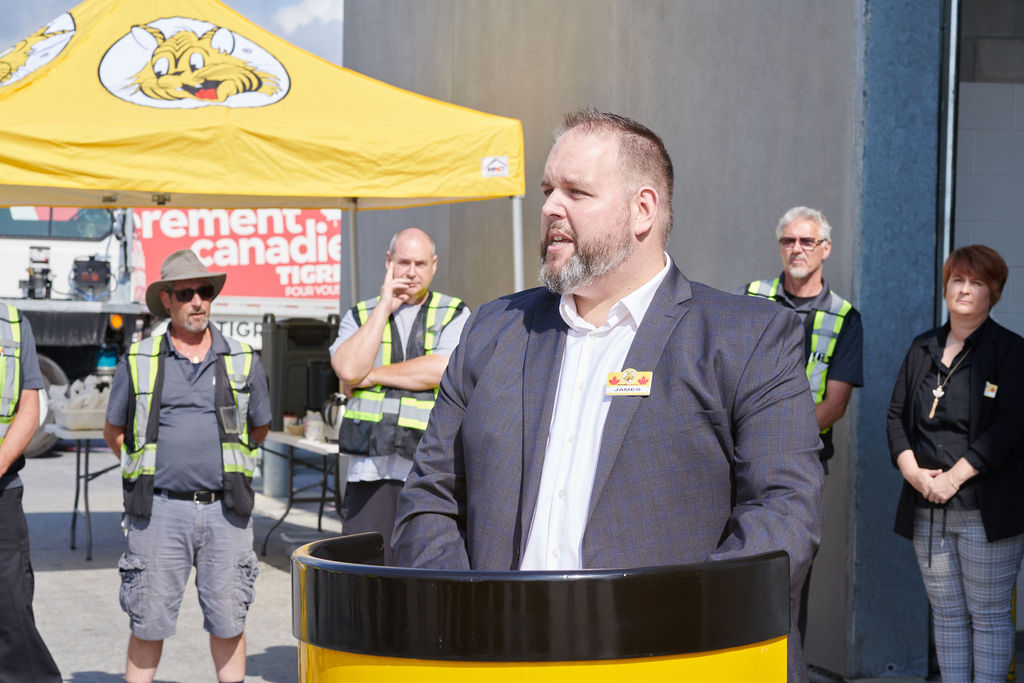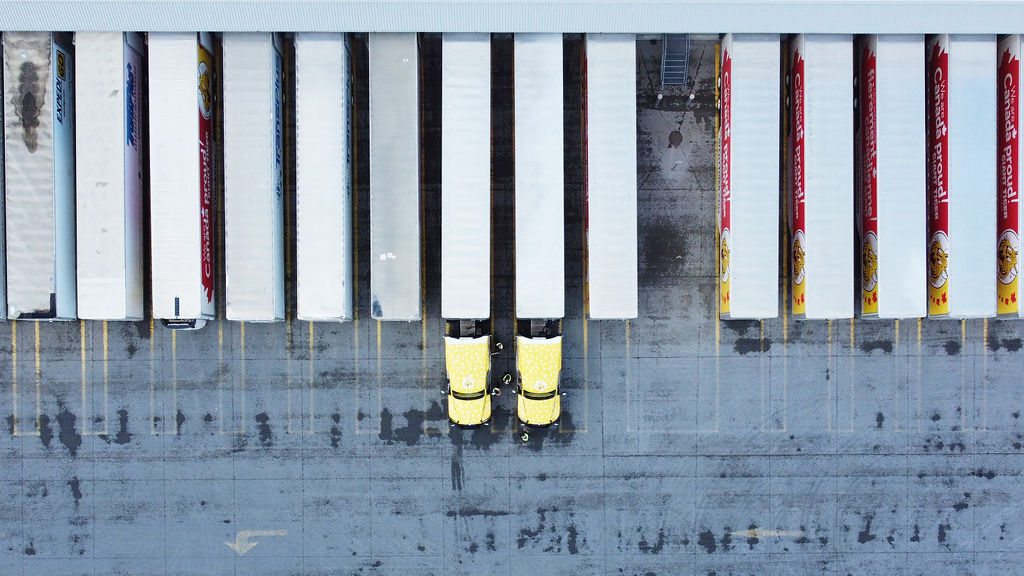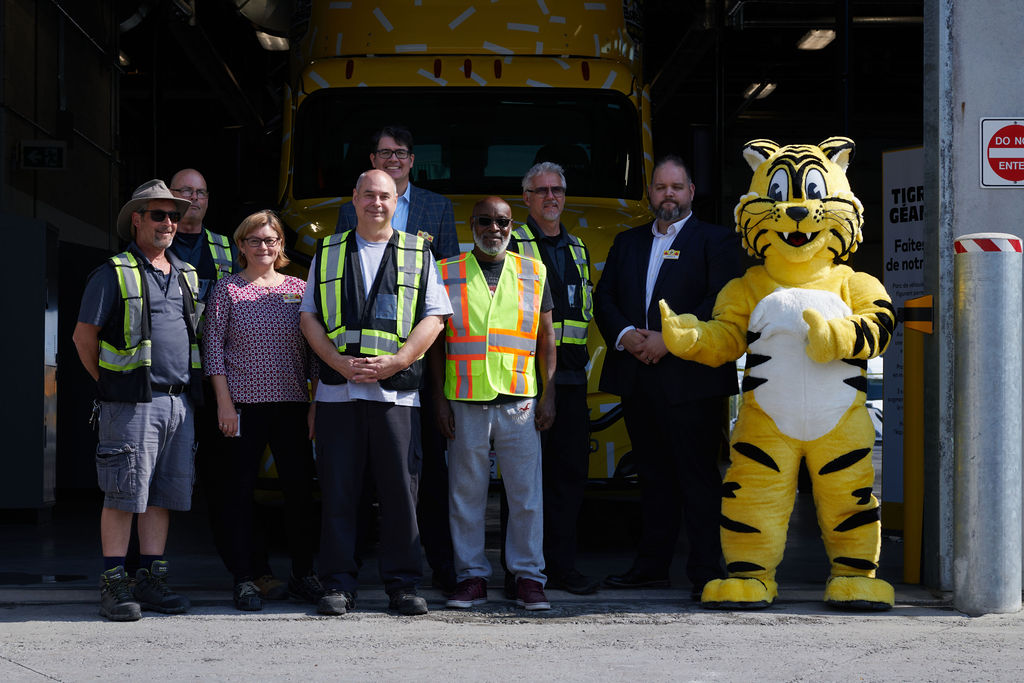Q&A with Tiger Trucking’s transportation head, James Johnstone
Giant Tiger has come a long way since the discount retailer secured its first trucks to serve stores in Eastern Ontario. Thirty-five years later its private fleet, Tiger Trucking, counts 150 power units, 400 trailers, 300 intermodal containers, and 60 chassis that serve 260 locations across Canada.
TruckNews.com spoke with James Johnstone, head of transportation at Giant Tiger, during the fleet’s 35th anniversary celebrations in Johnstown, Ontario, to discuss the organization’s philosophy.

Q. One of the things you’re celebrating today [Sept. 14] is the opening of a dedicated on-site shop run by Penske Truck Leasing and Frigid. What led you to decide this was a model you wanted to embrace?
There isn’t a lot of major service centers in our area, and there’s something lacking by having to shuttle a truck at least an hour each way to get service. For us, it just made sense from a safety, environmental and people perspective to have that service done here – to save the miles, save the fuel, and put someone doing productive work versus just shuttling empties back and forth. And from our partners’ perspective, there’s so much better care and control of the assets here. We are able to address things much quicker, and the lag time is totally reduced.
The growth of our fleet really called out how much time we were spending, shuttling equipment from A to B. We are one of the largest fleets in Eastern Canada – certainly one of the largest private fleets in all of Canada. It was time to cut down on the lead time for parts and service and get those trucks back on the road faster.
Q. Now this is just one of the latest investments you’ve made in your own fleet. Why is private trucking a better option for Giant Tiger than outsourcing the work to dedicated-contract or for-hire carriers?
There’s a clear savings. We’re paying our costs. There’s no markup. There’s no profit on that. And our drivers are truly invested in the company, our culture, our communities. So, we’re able to get the best service, the best equipment, the best drivers for the lowest-possible price.
Over the last few years our safety scores have also improved dramatically. Last year, [the Private Motor Truck Council of Canada’s fleet safety awards named Tiger Trucking] the most-improved fleet. Within our space, we’re hoping to be the best. We’re always striving to be Number 1 in terms of safety. It’s just the responsible thing to do.

There’s been a lot of supply chain issues across the board, and we’ve been insulated from them because we’ve had our own capabilities. We didn’t know there would be a pandemic, and then wildfires and floods, all the catastrophes we’ve had to deal with. But because we’ve had our own people, more often than not, everyone will step up when there’s something extra to do. Everyone understands what it means to the company overall. You can’t get that from a for-hire carrier. They just don’t have the same investment in the culture and the company.
Q. Where does Tiger Trucking grow from here?
As we continue to open stores we will continue to right-size our fleet to maintain the correct balance. Right now we’ve taken over the vast majority of all of our fresh and frozen [food] distribution across Ontario, Quebec, and in the Maritimes.
Q. How are you sourcing the new truck drivers you need to support that growth?
We have a phenomenal in-house training program where we will take someone from the warehouse and upgrade their skills slowly through accredited institutions. They’ll work their way up to becoming a shunt truck driver and then a DZ driver, then a regional truck driver, and then through a very safe environment where they can graduate to becoming a long-term AZ driver with the pay and the benefits that comes with that.
They’ve already joined our team. They’re part of the culture. So we’re kind of growing the next crop ourselves – but we’re [also] continuing to hire, to replace guys that have earned their time and are ready to retire.
Q. This distribution center in Johnstown, Ontario, is relatively isolated, and it’s fair to say that it’s not a trucking hotbed like the western Greater Toronto Area. Does that present a challenge in terms of being able to find candidates looking for trucking jobs?
One thing this community doesn’t have a shortage of is hardworking individuals with great moral character and a willingness to learn. We’ve had a tremendous response from the local labor market in terms of joining our fleet. The future growth [includes] people that are coming up through the ranks, the forklift operators you hear in the background today

Q. During today’s ceremonies, you also honored drivers who have logged 1, 2, 3 and 4 million miles. How have you managed to attract and keep these highly experienced people on your team, given that they are also coveted by other fleets?
Here, everyone is compensated fairly, they’re compensated by the hour, and our culture is safety and service. We’ve had drivers that ‘boomerang’, who leave because they see a posting somewhere else, and come right back. The environment that we offer our drivers is highly scheduled. You can see the equipment we offer them. They’re treated very well. They’re respected – and I think that’s something that’s been lacking throughout the industry. By and large, the driver shortage has been self-inflicted by a lot of carriers. We understand that, and whether it’s a driver or anyone else on our team, they’re all treated the same way and they appreciate that. It goes a long way.
Q. What’s the key to maintaining that commitment to safety, recognizing that there’s also pressure to keep things rolling?
There is a lot of pressure to keep things rolling, to keep utilization up. We don’t want to have extra trucks for the sake of having trucks. But we do a pre- and post-trip on every unit that comes in and out of here for every driver, so the trucks are touched multiple times before they go back out. We go a little overboard, but Giant Tiger is a very community-oriented organization and retailer. The last thing we want to do is put someone in danger.
And you can’t miss these trucks when they’re going down the road. You cut somebody off and they’re going to know who to call, right?
We do have some drivers that come in from other organizations that are “go, go, go”. We’re “hey, slow down. It’s OK. You’re being paid whether you’re in traffic, whether you’re waiting.” There’s nothing on that truck that’s worth risking your safety or the public.
- This interview has been edited for length and clarity
Have your say
This is a moderated forum. Comments will no longer be published unless they are accompanied by a first and last name and a verifiable email address. (Today's Trucking will not publish or share the email address.) Profane language and content deemed to be libelous, racist, or threatening in nature will not be published under any circumstances.
-
No they don’t, do some research please.
Great article however they remain under the industry standard wages.